Knowledge
Dried Oyster
Introduction:
Dried oyster are processed from fresh oysters and suitable for the autumn and winter season. Dried oysters are usually divided into the three types of: dried oyster, sun-dried oyster and half-dried oyster. During New Year and festivals, they are very popular.
- Japanese dried oysters → From Hiroshima, Japan. High quality, bright color, with the edges slightly dark. Strong taste and aroma, rich in oils, plump and dry, excellent for braising, stewing or making soup.
- South Korean dried oysters → From South Korea, also called the "pearl oysters". Round in shape and not as big as Japanese ones. Appear dark green in color, with stronger fishy smell. Suitable for soup or porridge.
- sun-dried oyster → From Guangdong, China. The most famous is Shajing oysters. Choose fat and plump fresh oysters and skew with bamboo sticks. Sun-dried to 80% dry, thus preserving the best of fresh oysters. Plump and smooth, sweet in taste.
- Half-dried oyster → From Shajing in Guangdong, China. Boil Fresh oysters and dry and dehumidify to 50 to 60% dry. Plump and nice body with sweet taste.
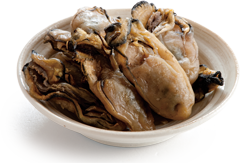 Functions:
Functions:
Dried oysters are famous for regulating body organs and supplementing weak functions, nourishing the Yin and the blood, invigorating the kidneys and strengthens male functions. Rich in proteins and various nutrients, and is a precious food for improving skin and beauty.
Characteristics:
Sweet in taste, warm in nature.
Processing method:
Soak Japanese dried oysters in water for 2 hours (depending on size) and rinse with water. Ready for cooking.
Way of Storage:
It is better to store Japanese dried oysters in freezer (-18˚C or below).
Other notes:
Japanese dried oysters are great for stewing and making soup to give the aroma and sweet taste, while sun-dried oysters are suitable for frying or steaming and perfect with alcoholic beverages or rice.
Dried Shrimp
Introduction:
Dried shrimps are made by removing shells of fresh sea shrimps and drying them. Mostly produced in Thailand, China and Vietnam, among which Thai dried shrimps are the most famous and best ones. Annan dried shrimps from Vietnam, on the other hand, are famous for prolonged storage period.
- Thai Dried black tiger shrimp → From Thailand, bright red in color. Wet and soft. Tender meat and sweet taste, with the strongest aroma.
- Thai Dried crystal shrimp → From Thailand, bright yellowish red in color. Dry and heavy. Tender meat and sweet taste, with strong aroma.
- Chinese dried shrimp → From Zhanjiang, Guangdong, China. Appear light red in color. Dry and heavy. Firm texture, light and sweet with aroma.
- Annan dried shrimp → From Vietnam. Appear rather red. Dry and heavy. Firm texture, saltier, with aroma.
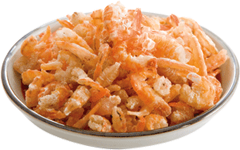 Functions:
Functions:
Dried shrimps invigorate the kidneys and strengthen male functions. It also contains sugars, minerals and various vitamins. Nutritious, rich in proteins and low in fats.
Characteristics:
Sweet in taste and warm in nature.
Processing method:
Soak the dried shrimps in water for around half an hour (depending on size), rinse with water. Ready for cooking.
Way of Storage:
Dried shrimps should be place in refrigerator (0-8˚C). If it is to be stored for some time before serving, it is better to seal properly and place in freezer (-18˚C or below).
Dried Prawn
Introduction:
Dried prawns are made by removing shells from cooked fresh prawns and sun-drying them. Bigger than dried shrimps in size and richer in texture. Divided into "freshly sun-dried" and "premium" dried prawns. Most are produced in Guangdong, China and Hong Kong. Among them, the freshly sun-dried prawns are better in quality.
Special features:
- Freshly sun-dried prawns → From Guangdong, China and Hong Kong. Larger in size when compared to premium dried prawns. Dark Orange red in color, sweet and strong taste of prawn.
- Premium dried prawns → From Zhanjiang, Guangdong, China. Orange red in color, sweet but stronger fishy smell.
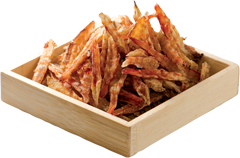 Functions:
Functions:
Dried prawns invigorate the kidneys and strengthen male functions. It also contains sugars, minerals and various vitamins. Nutritious, rich in proteins and low in fats.
Characteristics:
Sweet in taste and warm in nature.
Processing method:
Soak the dried shrimps in water for around half an hour (depending on size), rinse with water. Ready for cooking.
Way of storage:
Dried shrimps should be place in refrigerator (0-8˚C). If it is to be stored for some time before serving, it is better to seal properly and place in freezer (-18˚C or below).
Other notes:
For people suffering from heaty symptoms or allergic to shrimps, please avoid dried shrimps.
Dried Sea conch feet
Introduction:
There are fresh frozen and dried Sea conch feet. Fresh frozen ones are processed and frozen with fresh sea conch, while the dried sea conch feet refer to those being dried and processed. Produced in Australia, Middle-east, the USA and China.
- Dried Red Sea conch feet → From Middle East. Made of various fresh and assorted sea conchs. Since they are quickly boiled before sun-drying, they are especially sweet and strong in taste when used in soup.
- Freshly sun-dried sea conch feet → From the USA, Freshly sun-dried sea conch feet. Similar soaking process as for dried red sea conch feet, sweet and fresh taste.
- Dried sea conch cut open → From the USA, made by sun-drying fresh sea conch. Smaller pieces and colors are darker, slightly greenish. Lighter taste when made into soup.
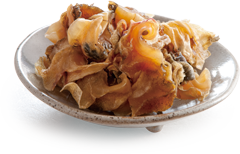 Functions:
Functions:
Dried Sea conch feet function to nourish the Yin and invigorate the kidneys. Highly nutritious and rich in protein, low in fats. Good for those lack in vital energy, have weak blood circulation or suffering from anaemia.
Characteristics:
Sweet in taste, mild in nature.
Processing method:
Soak in water for 12 hours (depending on size). Rinse and ready for cooking.
Way of storage:
Dried sea conch feet should be place in refrigerator (0-8˚C). If it is to be stored for some time before serving, it is better to seal properly and place in freezer (-18˚C or below).
Dried Octopus
Introduction:
There are three types of octopus: the Common Octopus (Octopus vulgaris), Long-armed Octopus and Short-armed Octopus. The taste is fresh and sweet, suitable for eating it fresh as well as drying to become Dried Octopus. Mainly produced in Shantou, Guangdong, China.
Special features:
Good dried octopus should have complete body, big and with thick meat, fresh aroma, look orange-red or brownish red and bright, and feel dry. Gives sweet taste for making soup and tastes best.
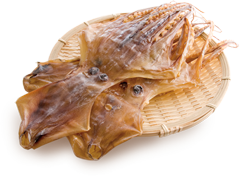 Fuctions:
Fuctions:
Dried octopus can replenish vital energy, nourish the blood, astringing and nourishing the skin. Rich in proteins, it is also great for women after giving birth to supplement and generate milk.
Characteristics:
Sweet in taste, mild in nature.
Processing method:
Soak in water for 6 hours (depending on size). Remove the slime and internal organs. Rinse and ready for cooking.
Way of storage:
Dried octopus should be place in refrigerator (0-8˚C). If it is to be stored for some time before serving, it is better to seal properly and place in freezer (-18˚C or below).
Other notes:
Dreid Octopus (2 taels), Honey dates (3 pieces), Peanuts (2 taels), Papaya (half), Ginger (3 slices), Pig's leg (1) → Make soup with the above ingredients to invigorate the spleen and comfort the stomach, nourish the blood and skin.
Dried squid
Introduction:
Dried Squid is divided into oval shape and longitudinal shape. The oval-shaped one is the Loligo and the long-shaped one is called Ommastrephidae with better quality. It is also called the squid steak. Mainly produced in Thailand, China and South Korea.
- Loligo → sun-dry Loligo to half-dried condition. Soft in texture but aroma is stronger than squid steak. The most famous is Kowloon Squid.
- Squid steak → flat and thin, bright in color, reddish meat and refreshing aroma. Those with complete body, even, bright and clean, dry are the best ones.
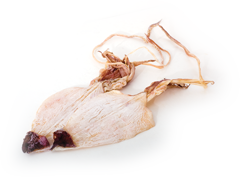 Functions:
Functions:
Dried squid can replenish vital energy and blood, strengthen body and bones. It is not just rich in nutrients, but also rich in proteins and several vitamins.
Characteristics:
Sweet in taste, mild in nature.
Processing method:
Soak in water for 2 hours (depending on size). Remove the slime and cartilage. Rinse and ready for cooking.
Way of storage:
Dried squid should be place in refrigerator (0-8˚C). If it is to be stored for some time before serving, it is better to seal properly and place in freezer (-18˚C or below).
Other notes:
Besides making soup, dried squid can be heated in an oven or toaster until crispy. Tastes like roasted squid on the street!
Smelt
Introduction:
Japanese Smelt is a kind of small Anchovy fish, mainly living in Pacific Ocean and Indian Ocean, As it is too small and not easy to long journey transportation. Only will be sold in live situation locally and will be dried for export in common. Mainly produced in China and Japan.
Special features:
The tail fin of the Smelt appears fork liked, the body with white and yellow strips. Two green brindles on the top of it's head. There is silver strip at the side of the body. There are slso some small black spots on it back. Tail fin is yellow and the edge is green, other fins are grey and white in colour. The colour is very sharp. The fresh Smelt's taste is much better.
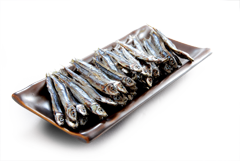 Functions:
Functions:
Smelt is highly nutritional and famous as different kinds of Amino Acid which are very needed for human body. It is also known as high protein low fat seafood.
Characteristics:
Sweet in taste, common in nature.
Processing method:
Cut the head and abdomen of the Smelt, soak in water for 1 hour approximately then can be cook as usual.
Way of storage:
Smelt should be place in refrigerator (0-8˚C ). If it is to be stored for some time before serving, it is better to seal properly and place in freezer (-18˚C or below).
Dried Silver Fish
Introduction:
Silver Fish is in fact a general name, including various kinds of dried fish under the Family Salangidae - Icefishes or noodlefishes, such as Hemisalanx brachyrostralis, Hemisalanx brachyrostralis, Salanx ariakensis, Protosalanx chinensis and shortnose noodlefish. Mainly produced in Jiangsu, China.
Special features:
With their long and small body, their bodies are transparent when alive and after drying, appear milky white. Great when freshly served, frozen or sun-dried as dried silver fish. Those with complete body, white as silver, transparent and bright, sweet are of the best quality.
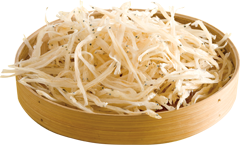 Functions:
Functions:
Supplement weak body organs, strengthen stomach functions, invigorate the lungs and promotes water circulation. Nutritious, rich in proteins and low in fats. Suitable for malnutrition, problems with digestion or childhood malnutrition (when the tummy is big and the legs are small) in small kids.
Characteristics:
Sweet in taste, mild in nature.
Processing method:
Dried silver fish are to be soaked in water for 15 minutes (depending on size). Rinse and ready for cooking.
Way of storage:
Dried Silver Fish should be place in refrigerator (0-8˚C). If it is to be stored for some time before serving, it is better to seal properly and place in freezer (-18˚C or below).
Other notes:
Usually the silver fish are dried in nets with complete body and whitish color. Basically the meat is fresh and sweet as in fresh fish.
